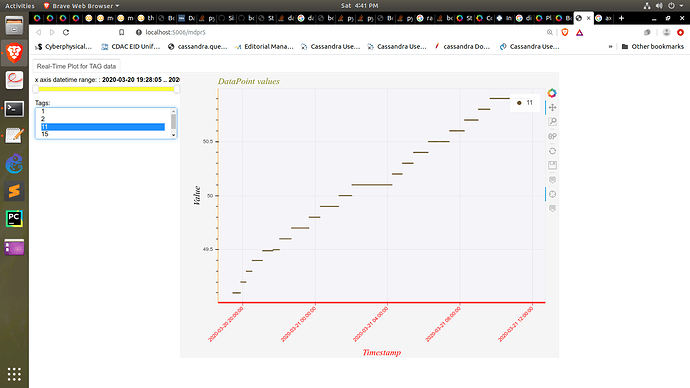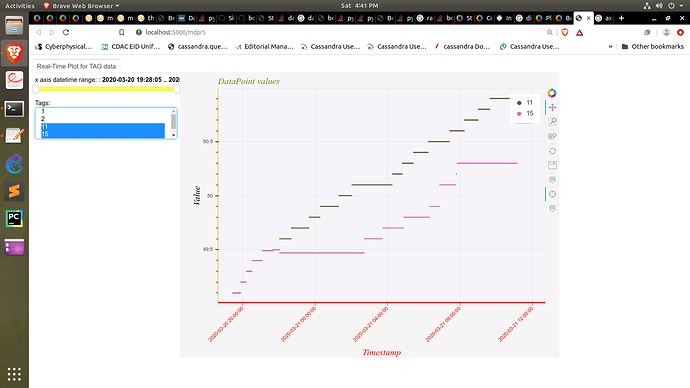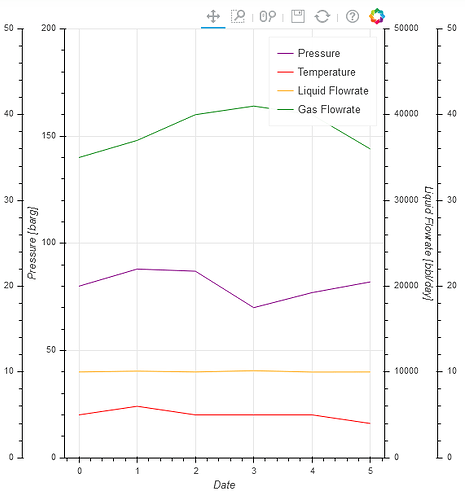As shown in the following set of figures, I add a line (actually scatter) for each Tag selected on the MultiSelect widget with different colour and same X and Y axes. I am simply doing it by modifying the columndatasource on change in the Select input as shown in the code below.
But what I want is to add (remove) extra y axis for each Tag selected on the widget, (something like in the 3rd figure). Please some one help me how to do that.
Here is my code:
import io
from math import pi
import requests
import pandas as pd
import datetime
from datetime import date
import numpy as np
from pytz import timezone
from bokeh.models import ColumnDataSource, HoverTool, SaveTool, MultiSelect, RadioGroup, Select, Panel, Tabs
from bokeh.models.formatters import DatetimeTickFormatter
from bokeh.models.widgets import TextInput, Button, DateRangeSlider
from bokeh.plotting import figure, curdoc, output_notebook, output_file, show
from bokeh.layouts import row, widgetbox, layout, column
output_notebook()
import random
r = lambda: random.randint(0,255)
dcu_data = pd.read_csv('/home/superusr/Desktop/colaboratory_python/dcu_data.csv')
dcu_data.sort_values("TAGID", ascending = True, inplace = True)
dcu_data['TAGDATETIME'] = pd.to_datetime(dcu_data['TAGDATETIME'])
dcu_data['Disp_TAGDATETIME'] = dcu_data['TAGDATETIME'].dt.strftime("%Y-%m-%d %H:%M:%S")
available_tags = list(dcu_data['TAGID'].unique())
available_tags.sort()
dcu_data['color']=np.nan
for i in available_tags:
colour=('#%02X%02X%02X' % (r(),r(),r()))
dcu_data.loc[dcu_data['TAGID'] == i, ['color']] = colour
tag_list = [str(x) for x in available_tags]
curTag=['{0}'.format(available_tags[0])]
curTag = list(map(int, curTag))
# print(curTag)
tag_data=dcu_data[dcu_data['TAGID'].isin(curTag)]
tag_data.sort_values("TAGDATETIME", ascending = True, inplace = True)
start_time=tag_data['TAGDATETIME'].iloc[-0]
end_time=tag_data['TAGDATETIME'].iloc[-1]
source=ColumnDataSource(tag_data)
p = figure(x_axis_type="datetime", plot_width=800, plot_height=600, title = 'DataPoint values',
x_axis_label = 'Timestamp', y_axis_label = 'Value',
tools = ['hover','box_zoom','wheel_zoom', 'pan','reset', 'save', 'crosshair'],
toolbar_location="right")
def make_plot(source):
graph1=p.circle(x='TAGDATETIME', y='TAGVALUE', line_color = 'color',
source=source, legend = 'TAGID', fill_color='color', hover_fill_color = 'color', size=1)
hover = HoverTool(tooltips = [('Timestamp', '@Disp_TAGDATETIME'),
('Tagtype', '@TAGTYPE'),
('TagId', '@TAGID'),
('Value', '@TAGVALUE')], mode = 'vline')
p.add_tools(hover)
p.xaxis.formatter=DatetimeTickFormatter(
hours=["%Y-%m-%d %H:%M:%S"],
days=["%Y-%m-%d %H:%M:%S"],
months=["%Y-%m-%d %H:%M:%S"],
years=["%Y-%m-%d %H:%M:%S"],
)
p.background_fill_color = "#ebe9f2" #"beige"
p.background_fill_alpha = 0.5
p.border_fill_color = "whitesmoke"
p.min_border_left = 80
p.title.text_color = "olive"
p.title.text_font = "times"
p.title.text_font_style = "italic"
p.title.align = 'left'
p.title.text_font_size = '14pt'
p.xaxis.major_label_orientation = pi/4
p.xaxis.axis_line_width = 3
p.xaxis.axis_line_color = "red"
p.xaxis.major_label_text_color = "red"
p.yaxis.axis_line_color = "orange"
p.xaxis.major_tick_line_color = "firebrick"
p.xaxis.minor_tick_line_color = "orange"
p.xaxis.axis_label_text_font = 'times'
p.yaxis.axis_label_text_font = 'times'
p.xaxis.axis_label_text_font_style = 'italic'
p.yaxis.axis_label_text_font_style = 'italic'
p.xaxis.axis_label_text_color = 'red'
p.yaxis.axis_label_text_color = 'black'
p.xaxis.axis_label_text_font_size = '14pt'
p.xaxis.major_label_text_font_size = '8pt'
p.yaxis.axis_label_text_font_size = '14pt'
p.yaxis.major_label_text_font_size = '8pt'
return p
def getLiveData(lastTimeStamp):
global dcu_data
df_liveData=pd.DataFrame({'TAGID': [1, 2, 11, 15, 25],
'TELEGRAMNO': [1, 2, 11, 15, 25],
'METERID': [1, 1, 1, 1, 1],
'DCUID': [1, 1, 1, 1, 1],
'TAGTYPE': [12, 12, 10, 10, 10],
'TAGVALUE': [230.75, 228.70, 49.84, 50.01, 50.63],
'UNIT': [38, 38, 35, 35, 35],
'TAGDATETIME': ['2020-03-22 00:01:00', '2020-03-22 00:02:00', '2020-03-22 00:03:00', '2020-03-22 00:04:00', '2020-03-22 00:05:00'],
'TIMEBLOCK': [1, 1, 1, 1, 1],
'color':[0,0,0,0,0]})
df_liveData['TAGDATETIME'] = pd.to_datetime(df_liveData['TAGDATETIME'])
df_liveData['Disp_TAGDATETIME'] = df_liveData['TAGDATETIME'].dt.strftime("%Y-%m-%d %H:%M:%S")
dcu_data.append(df_liveData, ignore_index = True)
#print(dcu_data.head())
return df_liveData
def getNewTagDataset(curTag, start_time, end_time):
tag_data=dcu_data[dcu_data['TAGID'].isin(curTag)]
tag_data=tag_data[tag_data['TAGDATETIME']>=start_time]
tag_data=tag_data[tag_data['TAGDATETIME']<=end_time]
newSource=ColumnDataSource(tag_data)
return newSource;
def tag_select_handler(attr, old, new):
curTag=[i for i in tag_select.value]
curTag = list(map(int, curTag))
new_src = getNewTagDataset(curTag, start_time, end_time)
source.data.update(new_src.data)
return
def date_range_update(attrname, old, new):
global start_time
global end_time
range_dt = list(date_range_slider.value)
st="{0}".format(range_dt[0])
et="{0}".format(range_dt[1])
st=int(st)/1000.0
et=int(et)/1000.0
st=datetime.datetime.utcfromtimestamp(st).strftime('%Y-%m-%d %H:%M:%S')
et=datetime.datetime.utcfromtimestamp(et).strftime('%Y-%m-%d %H:%M:%S')
start_time=pd.to_datetime(st)
end_time=pd.to_datetime(et)
new_src=tag_data[tag_data['TAGDATETIME']>=start_time]
new_src=new_src[new_src['TAGDATETIME']<=end_time]
newSource=ColumnDataSource(new_src)
source.data.update(newSource.data)
return
date_range_slider = DateRangeSlider(title="datetime range: ",orientation='horizontal', start=start_time, end=end_time, value=(start_time, end_time), step=1, format="%Y-%m-%d %H:%M:%S", width=300, bar_color='yellow', align='start')
date_range_slider.on_change('value', date_range_update)
tag_select = MultiSelect(title="Tags:", value=['{0}'.format(tag_list[0])], options=tag_list) #where value='line' says initial option selected by default
tag_select.on_change("value", tag_select_handler)
curTag=[i for i in tag_select.value]
curTag = list(map(int, curTag))
range_dt = list(date_range_slider.value)
st="{0}".format(range_dt[0])
et="{0}".format(range_dt[1])
start_time=pd.to_datetime(st)
end_time=pd.to_datetime(et)
source = getNewTagDataset(curTag, start_time, end_time)
p = make_plot(source)
layout = row(column(date_range_slider,tag_select), p)
tab = Panel(child=layout, title='Real-Time Plot for TAG data')
tabs = Tabs(tabs=[tab])
curdoc().add_root(tabs)

